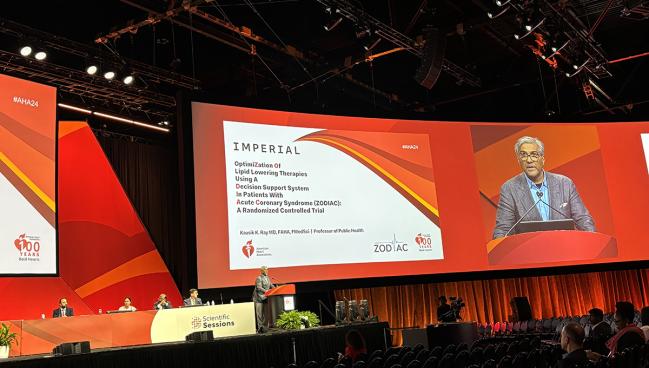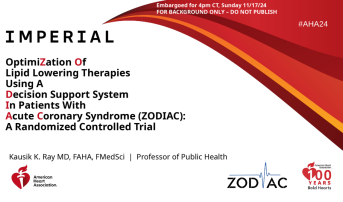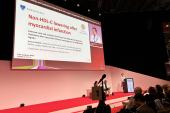ZODIAC: Decision-Support Tool Doesn’t Sway Lipid-Lowering Treatments in ACS
The observed changes were favorable, but results may have been affected by better-than-normal care in the control arm.

CHICAGO, IL—A decision-support tool failed to significantly increase the use of combination therapy or intensification of current lipid-lowering regimens compared with usual care in patients recently hospitalized with an acute coronary syndromes, interim results of the ZODIAC cluster-randomized study show.
Despite missing the trial missing its primary endpoint, investigators did observe favorable shifts in prescribing behavior, with physicians giving more-potent combination therapies when using the decision-support system (DSS).
Kausik K. Ray, MD (Imperial College London, England), who led ZODIAC, said that physicians in the usual-care arm performed exceptionally well over the relatively short 16-week study, noting they were much more likely to use combination therapy than anticipated.
“Seventy percent of patients are treatment-naive when they come in with a heart attack,” Ray told TCTMD. “So, they’re actually getting a drug for the very first time. We know that this is usually done in a stepwise way, and we have seen [historically] in that time window, the likelihood of using combination therapy is less than 10%.”
However, possibly by virtue of being observed, clinicians in the usual-care arm exceeded that threshold, said Ray. More than 20% used combination therapy with high-dose statins, ezetimibe, bempedoic acid, or PCSK9 inhibitors that would lower LDL cholesterol by more than 65%, while nearly 70% were using drugs and/or combinations that cut LDL cholesterol levels in half or more.
Another possibility is that these physicians were simply more aggressive than what’s currently recommended. “Even though the guidelines talk about a stepwise approach, some people may have just adopted the approach of going with more combination therapy,” said Ray.
Can’t Get to Goal With Single Drug
The ZODIAC study, which was presented this week at the American Heart Association 2024 Scientific Sessions, attempted to address the undertreatment of high-risk patients hospitalized with ACS. Very few patients get to the recommended LDL cholesterol targets after MI, said Ray, noting that just one in four achieve levels less than 1.4 mmol/L (< 55 mg/dL) when prescribed statin monotherapy within 3 months of ACS.
“You cannot get to those goals unless you use more combination therapy,” he said. Even with high-intensity statin therapy, “those goals are too far away.”
Another aspect to consider is that the guideline-recommended stepwise approach to lowering LDL cholesterol takes time, meaning there is a delay in getting to goal. In an analysis of more than 56,000 patients in the SWEDEHEART registry published earlier this year, investigators showed that early and sustained lowering of non-HDL cholesterol after MI was associated with better outcomes. Those patients had a lower risk of recurrent events even when compared with patients who got to goal, but who took longer to get there.
“What if, instead of looking at a single metric, cholesterol, we had something that was a little bit more personalized?” said Ray. “Can we nudge, if you will, the behavior of the physician prescribing medication?”
With the DSS, physicians could visualize the effects of treatment by using patient demographics to predict the risk of atherosclerotic cardiovascular disease. The DSS allowed physicians to calculate that risk over an extended time horizon and to plot different scenarios—no treatment, statin monotherapy, or combinations—to visualize how it could be altered with additional LDL cholesterol-lowering.
In the UK, Italy, and Spain, 42 sites with 1,139 post-ACS patients (≤ 72 hours) were recruited for the study and randomized to deliver standard care or to use the DSS, with follow-up lasting 16 weeks. Importantly, physicians at sites randomized to the DSS were not told what to prescribe, but simply given a visualization of the potential risks and benefits of different treatment options. At baseline, median LDL cholesterol was roughly 116 mg/dL.
While the majority of patients were treatment-naive upon ACS admission, most of those who were on treatment were taking a moderate-intensity statin. Use of a high-intensity statin at baseline was infrequent, around 4%, as was the use of combination therapy.
For the preliminary analysis, which includes data from 33 sites, use of the DSS was not associated with a significant difference in the primary endpoint—the initiation/escalation of combination therapy or the intensification of monotherapy—when compared with usual care (adjusted risk ratio 1.15; 95% CI 0.93-1.41).
Looking at the results in more detail, which Ray cautioned should be “descriptive only” since the primary endpoint was not met, the researchers showed that 51.2% of patients in the standard-care arm were prescribed a high-intensity statin compared with 39.1% in the DSS arm. Roughly equal numbers of patients were prescribed high-intensity lipid-lowering combination therapy (18.4% with usual care vs 19.2% with the DSS), but use of very-high-intensity combination therapy was higher in the DSS arm (35.7% vs 22.1% with usual care).
More patients treated via the DSS pathway received their first lipid-lowering therapy escalation before discharge (64.3% vs 55.4% with usual care). In terms of getting to a target of less than 55 mg/dL at 16 weeks, numbers were higher with the DSS but still impressive with usual care (54.7% vs 48.7%).
Slow-moving Cycle of Care
Tracy Wang, MD (Patient-Centered Outcomes Research Institute, Washington, DC), who served as the discussant following Ray’s presentation, acknowledged the difficulty of getting ACS patients to goal and noted there is a persistent underutilization of lipid-lowering therapies.
“We can prescribe someone lipid-lowering therapy at discharge and then we send them home,” she said. “Then we bring them back and measure their LDL and we schedule follow-up to be able to discuss those LDL results. If they’re not a goal, we’re going to need to intensify. We send them home again and then a little bit later we bring them back in to measure. Sometimes we need to repeat that cycle once, twice, or more than that. That process can take months, maybe even years.”
Wang was impressed with ZODIAC, saying it’s “amazing to see a study that’s starting before the patient leaves the hospital,” a period when motivation is highest for secondary prevention. Moreover, the study doesn’t assume that “one-size-fits-all” and leaves room for patient and clinician preferences.
Like Ray, she questioned whether the results of the study might have been impacted by the Hawthorne effect, with a large proportion of physicians in the usual-care arm receiving therapies that provide considerable LDL cholesterol-lowering.
In terms of what’s next, Wang said research has shown that physicians will opt out of decision-support tools, and that the field needs to think more broadly about some of the sticking points in secondary prevention, such as patient access and adherence, as well as broaching the “chasm” as patients transition from the hospital to outpatient setting.
Michael O’Riordan is the Managing Editor for TCTMD. He completed his undergraduate degrees at Queen’s University in Kingston, ON, and…
Read Full BioSources
Ray KK, on behalf of the ZODIAC investigators. Optimization of lipid-lowering therapies using a decision-support system in patients with acute coronary syndrome (ZODIAC): a randomized controlled trial. Presented at: AHA 2024. November 17, 2024. Chicago, IL.
Disclosures
- Ray reports receiving grants from Amarin, Amgen, Sanofi, Regeneron, Daiichi Sankyo, and Ultragenyx; receiving consulting and/or lecture fees from Novartis, Boehringer Ingelheim, Biologix Pharma, AstraZeneca, Amgen, Amarin, Daiichi Sankyo, Kowa, Esperion, Novo Nordisk, MSD, Lilly, Silence Therapeutics, Sanofi, NewAmsterdam Pharma, Bayer, Beren Therapeutics, Macleod Pharma, Cleerly, EmendoBio, Scribe, Crispr, Vaxxinity, Viatris, Regeneron, Ultragenyx, Cargene, and Resverlogix; and holding stock options from NewAmsterdam Pharma and Pemi31.
- Wang reports no relevant conflicts of interest.






Comments